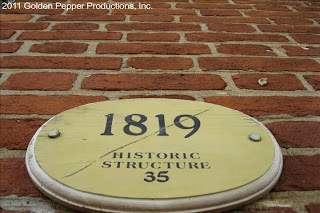Sometimes I have a hard time comprehending how buildings can stand for so long. I see the cornerstones, read the dates from 60 or 70 years ago, but still can't believe something can be in such good shape so many years later. When I see one that was built in 1819, surrounded by others that are even older, I'm even more surprised. I marvel at how well those buildings must have been constructed to be able to withstand 192 years of wind, rain, snow, excessive heat - anything that is experienced in nature. How solid is the concrete between each stone - even better, how strong are the stones themselves to not chip away to nothing! When I consider how after a couple of years a t-shirt starts to show its age, I have an even greater appreciation for anything that is still standing nearly two centuries later.
As I was walking by this building, recently, I started to imagine what the area looked like in 1819. Was their even a street in front or did the door take you out to a large, open field. What was its original purpose? What could you see from standing on the front porch...corn fields miles away or the predecessor to the main street that is currently a couple of blocks over? Did the building look the same or were the shutters a different color, if there were shutters at all?
All of these questions, to me, are so exciting and offer an opportunity to learn more. At the same time, my imagination can wander for a few minutes as I ponder the different possibilities. The next question is usually, "what will it look like in another hundred years"? The answer to that usually comes from its past, since historians usually try to restore old buildings to their original appearance. Much like with any part of history, how do you know where you're going unless you know the path you've taken so far. Extreme care is used to protect the structure and not damage any of ancient materials. Crews usually research different aspects of the design and construction as a way of replicating the process.
With all of this fresh in mind, I was attending a meeting where a friend of mine brought up the idea of where we would like our businesses to be in another 10 years, what do we do to get there, and what will be needed when we get to that point? It is never too early to ask those questions. I'm sure many of us have goals and a plan of where we would like our business/career to be in the next few years; how many of us though have really considered how to get there and having arrived, what is our next step? What sort of resources will be most beneficial to a thriving, solid business. Everyone, rightfully so, is focused on helping new businesses get off the ground and find ways to succeed; but after reaching your "goal" you don't suddenly say, "I'm done accepting advice and new information, now I'm ready to do it on my own!"
What do you want your business to "look like" in another 5, 10, 15 years? Have you laid a strong foundation, using "quality materials" to ensure its survival? What will be needed down the road to maintain that stability and will your current resources still be available? It isn't so simple as to just have a goal in mind without considering the path or what to do after reaching that point?
I don't think the people who constructed this building in 1819 had any idea it would still be around 192 years later, but they certainly built it with some thought towards the future. Build something to the best of your ability, considering every aspect, and your efforts will be rewarded!
That's the Golden Perspective...what's yours?
Subscribe to:
Post Comments (Atom)

No comments:
Post a Comment